PAGE 63 – July 2007
H O T I D E A S F O R S M A L L R A I L R O A D S
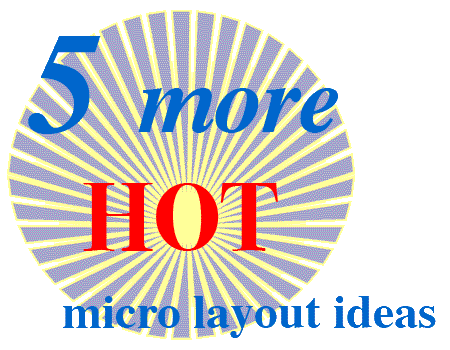
Last year I published an article called “5 Hot Ideas for Micro Layouts” in Scale Rails/NMRA Bulletin, the magazine of the U.S. National Model Railroad Association. Several people have recently asked me, “So what else is new?”
Well, our files are far from empty! So here are 5 More Hot Ideas from our archives — ideas that you may have seen before, but presented here in new and (I hope) thought-provoking ways.
Just the thing to occupy our minds while we wile away the summer hours thinking about the modeling that we’ll be doing in the autumn! (Note: This site will be on a relaxed schedule for summer. Watch the RSS feed!)
1. THE POWER-PACKED PENCIL BOX!
The basic idea behind micro layouts is the challenge of packing as much railroading as possible into the least amount of space. Nowhere is this notion better illustrated that in the wonderful little H0 layout, Finnegan, built by Bart Bakker, from Utrecht in the Netherlands, in a Tekendoos — a Dutch pencil box!
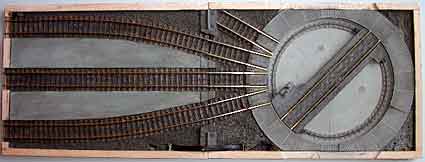
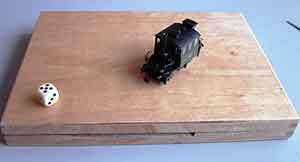
The Tekendoos (above right) is the size of an A4 sheet of letter paper — 210x297mm (8.3×11.7in) and about 25mm (1in) high. Bart packed in a Fleischmann turntable that is just long enough to hold a very small switching loco (a Bavarian Glaskasten – “glass box”) and one standard-sized European freight car. There is also room for three sidings (holding three cars each) and a short switcher pocket coming from the turntable. This trackage arrangement is enough to support two different, fairly complex shunting games, all in the space of two letter-sized sheets of paper placed end to end.
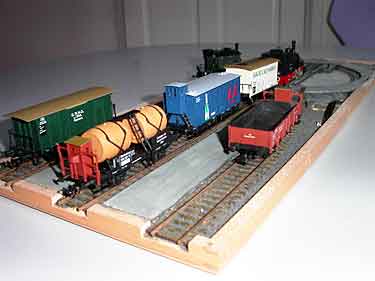
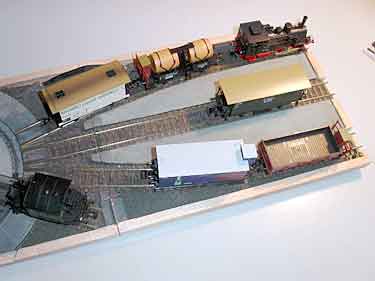
The two switching games are played using two dice: a regular die for choosing where to spot a car (six choices) and a colored die to choose which car to spot (notice that each car is a different color). Uncoupling is done by hand, with a modified Rix tool. The games work like this.
First, the Arrival (above left). The road engine arrives (is placed) on the middle track, with three cars. Throw dice to determine where the incoming cars should be spotted. Perform the shunting to spot the cars and to form an outgoing train from the two cars that were already spotted on the sidings. This switching will take awhile in these cramped quarters!
The second game is the Departure (above right). It begins with the road engine being serviced at the end of the departure track (as shown) and with five cars spotted elsewhere on the sidings. Throw dice to determine which three cars will be outgoing, in what sequence. Make up the outgoing train in the order of selection, with the road engine in front. Another challenging activity!
Notice that often both locomotives must work together to accomplish the job, which enhances the fun (no DCC on this layout!). Bart has also made the box open ended for the sidings, so he can add extensions for longer trains and can even play an Inglenook-style shunting game involving eight cars. He also can add the little layout to the end of the yard on his home FREMO layout.
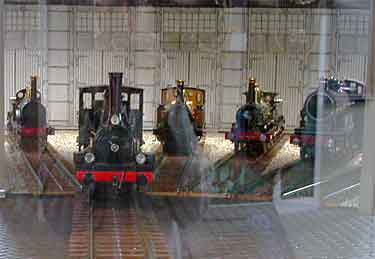
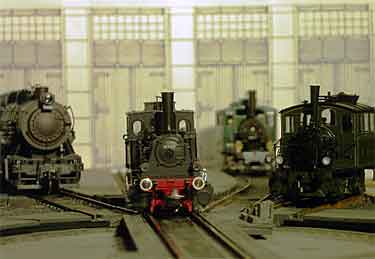
Believe it or not, there is a prototype for Finnegan, albeit a model prototype! Bart explains, “In the National Railway Museum in Utrecht there is a turntable of about two meters diameter, on which visitors can choose a precious model engine (scale 1 to 10) for display [above left]. The engine runs onto the turntable, makes a full turn, the public says ‘Ahhhhh,’ and then the loco retreats happily on its track.” Bart can duplicate this activity on his tiny layout (above right) and show off his locomotive collection at the same time!
Why is the layout called “Finnegan”? That engaging story is told in the original article about this layout, which appeared in our “Micro Layout Design Gallery,” archived on this site.
2. LET’S GET THIS STRAIGHT!
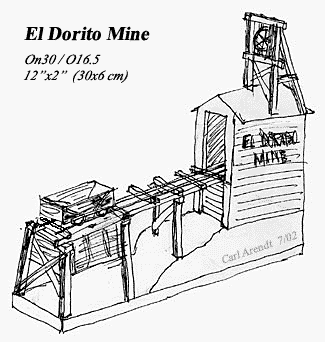
The simplest possible layout is probably a short piece of dead straight track. Believe it or not, this plan for a micro layout can provide a considerable amount of completely prototypical railroad operation! There are lots of examples in the “Micro Layout Design Gallery,” but here are a couple classic designs to give you the idea.
At the right is my design for El Dorito Mine, a narrow gauge mining road that fits into 12x2in (30x5cm) in Gn15 or O narrow gauge. In N or HO narrow gauge it will fit on a six-inch (15cm) ruler.
It’s a spoils dump… the little gondola starts out in the head house, where the waste soil and rock is hoisted to the surface and dumped into the car. Then it proceeds out to the end of the track, dumps its load into the spoils pile, and returns for another load. In real life, this small railway is usually “human powered,” but it was not unheard of for a small locomotive “critter” to be assigned to this duty. If you can motorize a miner, more power to you! But most of us will use a quaint and miniscule critter. Don’t forget to motorize the hoist wheel, put a flashing light inside the shed and sound a loud klaxon to announce each load’s arrival at the top.
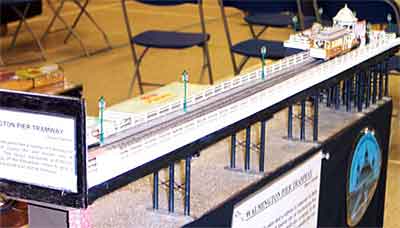
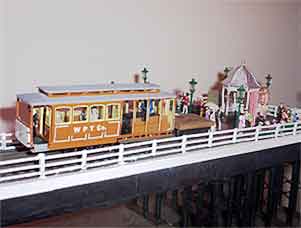
Another prototype that consists of a length of straight track is the pier railway, exemplified here (above) by Dave Carson’s Walmington Pier Tramway. This little railway features push-pull operation of a typical English seaside resort and pier in the Edwardian era, early in the Twentieth Century. This layout has been featured before in these pages, but above are two new photos showing recent updates including a new tram car body. Dave lives in Chelmsford, England, and recently retired from London Transport/Metronet to set up his own railway management consultancy.
I’d like to hear from anyone who knows of more “straight line” railway prototypes. For starters, one of the most delicious ones I know is the 30-foot-long peat railway at the Laphroaig Distillery, in Scotland!
3. ARE THREE STRAIGHT LINES 3x AS MUCH FUN?
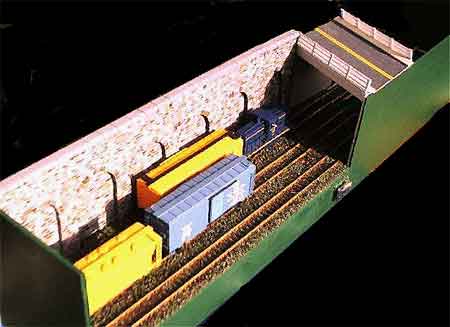
Adding more of a good thing seems like a fine idea, and Jack Trollope, from the Highlands of Scotland, added some more straight tracks to form Shortover Yard. It’s designed as a transfer yard in a generic American city, transferring cars between several railroads — though with a change of rolling stock it could be anywhere in the world. A single-track transfer table (traverser) connects the three spurs in the yard. There are no track switches.
Tripling the tracks more than trebles the complexity of switching puzzles available. Challenging operations can be programmed by randomly selecting cars to be moved and their destinations, perhaps by drawing tokens or cards from a hat or using a computerized selection program. It’s not unusual for one set of movements to take 45 minutes to an hour to complete — on an HO layout that measures 33x6in (84x15cm)! Because all trackage is straight and there are no turnouts, this is an ideal beginner’s layout, but it holds some pleasures for old timers as well. The only modeling difficulty might come in making the transfer table/traverser. Our Traverser FAQ has some good ideas to make this job easier.
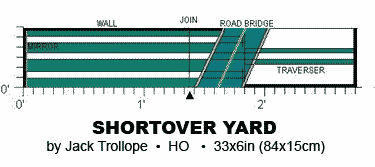
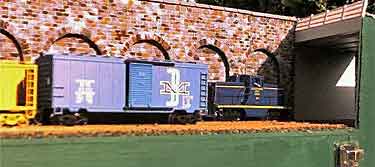
This layout is proof that everyone has room for a layout! In N scale, Jack reckons Shortover Yard would occupy about 24x4in (60x10cm)! This basic idea is so good that many people have begun to produce variations of it, in different settings and in a variety of scales. Here are some examples, to start your ideas rolling!
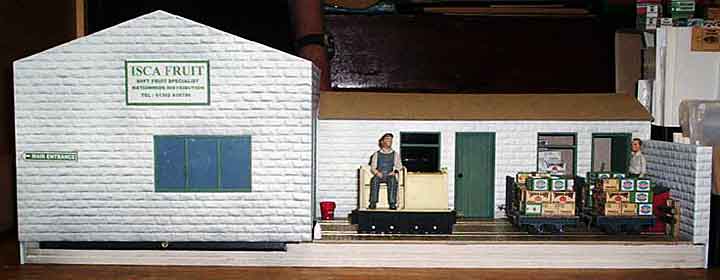
Steve Bennett, from Exeter, England, used the triple track trick to model a fruit-packing warehouse with a Gn15 tram to move cartons of fruit around the plant and out to their transshipment point. Isca Fruit measures 20x8in (50x20cm). The transfer table is hidden inside the warehouse building at the left. Two tracks are modeled in the open yard, and the third is hidden inside the building at the rear to avoid over-complicating the layout’s appearance in this tiny space. Steve uses link and pin couplers, uncoupling and coupling them by hand.
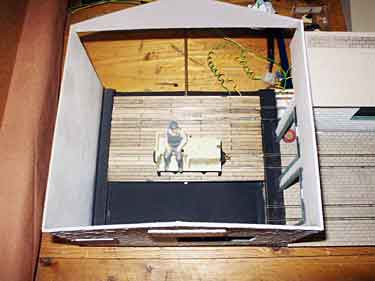
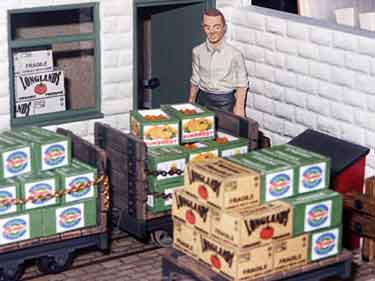
 Gerry Bullock, from Essex, England, is modeling a factory interior, also in Gn15. A small tramway moves parts and materials into and around the factory. In this case, the transfer table/traverser is in plain sight, a quite realistic arrangement. Gerry distributes electric current to the tracks through the metal guide rails under the table. Steve (above) has a hidden table, so can simply use flexible wire leads. | 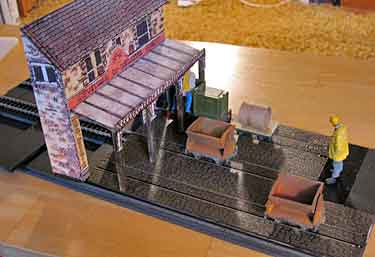 Whoops Wharf, also in Gn15, is my own contribution to the three-track genre. It’s a tramway built on a pier to haul freight from the ships to the warehouse and vice versa. The little tramway measures 20x8in (50x20cm) including fiddle yard. Shown under construction, the warehouse is an HO paper cutout enlarged four times to G scale dimensions. This traverser, like Steve’s, simply slides back and forth in a trough — a breakthrough idea from Andy Anderson. |
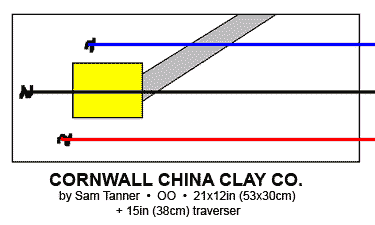 Sam Tanner, from Basildon, Essex, England, designed this 36x12in (90x30cm) layout (excluding fiddle) for OO scale. It represents a small china clay facility in Cornwall. Sam explains, “The concept is simple: Inbound wagons are set out on the blue siding. They are picked up by a Class 08 or 03 shunter and moved to the black siding, under the china clay loader. Once loaded, they are returned to the same blue siding, now as outbound wagons. The red siding is for general storage and stabling, likely to be occupied by an off duty shunter.” | 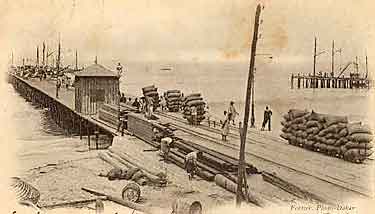 There’s a prototype for everything! To demonstrate that three parallel service tracks are both prototypical and feasible, here is a splendid narrow-gauge example from the closing years of the Nineteenth Century. This is the wharf at Dakar, Sénégal, with the year’s peanut crop being loaded on ships for transport to world markets. The peanuts have been brought down from the farms on tiny, narrow-gauge tram cars, piled high with bags. And the wharf trackage is – you guessed it – triple tracked! (Photo courtesy of the Sénégal National Archive.) |
4. THE CASE FOR THE PIVOT TABLE
A seldom used, but potent, layout design element is the centrally-pivoted sector table. It was used on the prototypes in many parts of the world. In the U.S. it was called a “pivot table” or “swing table.” It’s a track on a bridge, pivoted and balanced on its center, but turning only a short distance rather than 360 degrees like a turntable. The advantage of the pivot table is that it allows switching among several alternate tracks without requiring a space-consuming switch ladder. And of course, being entirely prototypical it can be left out in plain sight and enjoyed by your layout’s viewers!
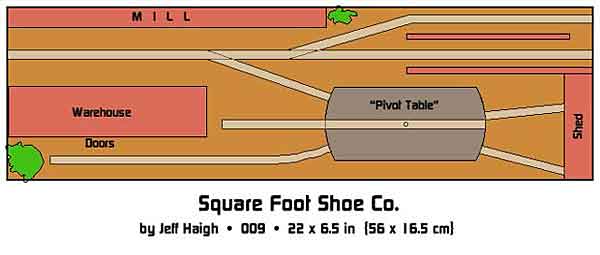
A good example of a Pivot Table in action is Jeff Haigh’s Square Foot Shoe Co., a very small layout in OO9 scale (4mm scale on 9mm gauge).
For his first micro layout, Jeff wanted to run a lot of rolling stock in a very small bookshelf, which led him to the pivot table idea. It’s front and center on the shelf and makes the whole layout design possible. Jeff describes the design, “Without any fiddle yards, the layout can operate three locos and�seven short trucks [four-wheeled tramcars].” Basically, the operation cosists of locomotives appear from behind the buidings at the right rear (representing the “Rest of the World”), switch back to the pivot table, and distribute the cars among the available sidings.
With three locos in action, it’s no small effort to keep things rolling without the stock getting completely gridlocked! And the table holds exactly one loco and two trucks – so one of the incoming trains will have three cars in its train, just to keep things interresting! Jeff lives near Northampton, England, a traditional center of shoe manufacture, and the buildings are modeled after industries in that area.
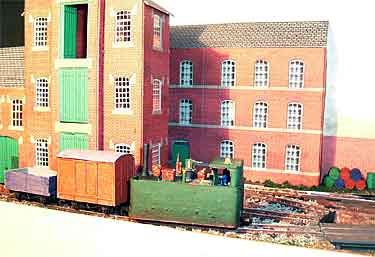
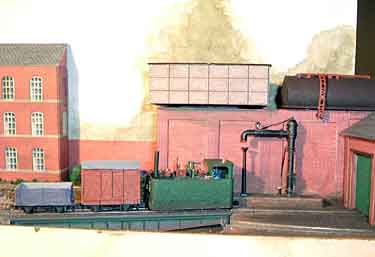
And in a variation on the same theme, we have a unique design from the irrepressible Carsten Weye Jensen, from Halstebro, Denmark. Carsten has put a double slip switch onto a pivot table in this Z scale extravaganza!
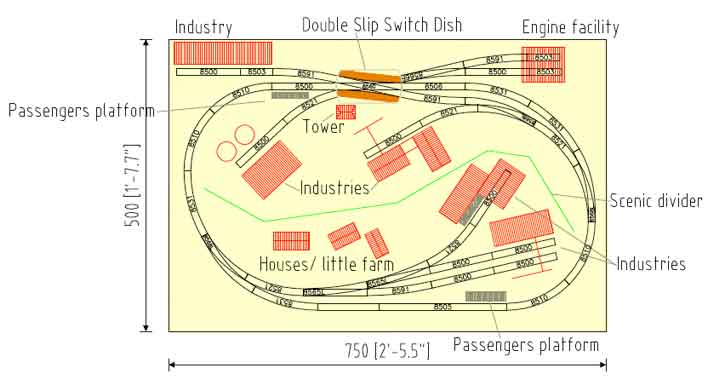
This layout is drawn for Z scale in a space of 750x500mm (30x20in). Use of the pivot table &mdash with a double-slip on it — allows a very flexible track plan for a small station in a very tiny space! Trace out the complex routings possible with this unusual track arrangement, and you’ll see how cleverly the space has been used in this design. The layout works well in N or Z scales or could even be an HOe or HOn30 narrow-gauge line.
5. HERE’S A TRULY ‘WAY OUT’ LAYOUT!
Every so often a layout idea comes along that is unlike anything you’ve ever seen before. Such a design is this one, from our highly imaginative frequent contributor, Jon Songøygard, who lives in Arendal, Norway. This design is located pretty far away from the sun to be regarded as a “hot idea,” but I hope it will give us all a healthy shot of out-of-the-box thinking!
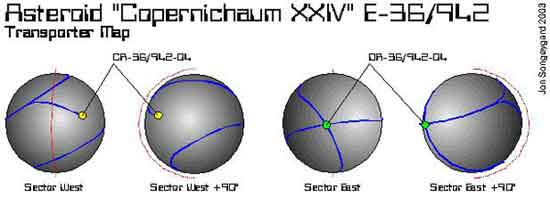
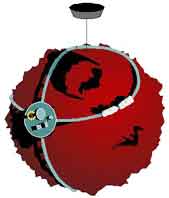
Meet Copernichaum. To quote its inventor: “Being ‘out in space’ today, I got the idea of an ‘asteroid railroad,’ modeled on a globe hanging down from the ceiling and spinning like a disco mirror ball. In fact one could even use a mirror ball motor for rotating this layout! Of course the footprint of the globe has to be within four square feet [the original limit of a micro layout], which gives us a globe with a diameter of about two feet [actually 27 inches or 68cm].
“Importantly, this conceptual asteroid now has a name. The astronauts like that, instead of saying ‘next week I’m going to E-36/942’! For the railway I’ve planned a simple figure-eight loop with one siding that could lead to a mine or perhaps a scientific centre (the yellow blob). Purpose of the railroad is to inspect the asteroid – to keep an eye on things, so to speak. Thus the track covers most of the globe (practical for our purpose!). The crossing (green spot) can be covered with a building, perhaps something spherical. Make it big enough, and everybody will understand that this is the headquarters!
“Scale? There are no rules. Design of rolling stock? No rules there either. Only one precaution: rolling stock must be capable of running upside down, hanging down from the south pole of the globe. Faller offers some roller coasters, perhaps there’s something of use. Or you could use U-beams the whole way, as in my attached drawing. Flashing lights and animated stuff would of course be fascinating, but this whole planet has to be held by that mirror ball motor up at the ceiling. Saving weight will be of importance. Giving current to the ‘orbiting’ train will be another matter – perhaps a battery-driven loco would do best.”
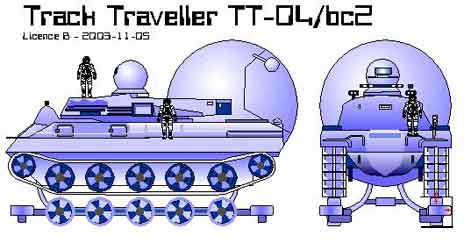
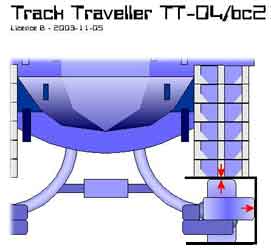
“I remembered an ad about radio controlled military tanks in 1:72 scale. I think these should be perfect as the base for making an asteroid train (see drawings for Track Traveller). Of course there may be some swirling dust on the surface of an asteroid (especially after all the digging starts), so it’s important to keep things on track. The tank tracks will make good traction, even if the track gets dusted. Also I’ve added lots of wheels for good traction! The wheels in front and rear of the unit are placed to run on the vertical part of the track rail, which is U-shaped to keep the train securely locked to the track.
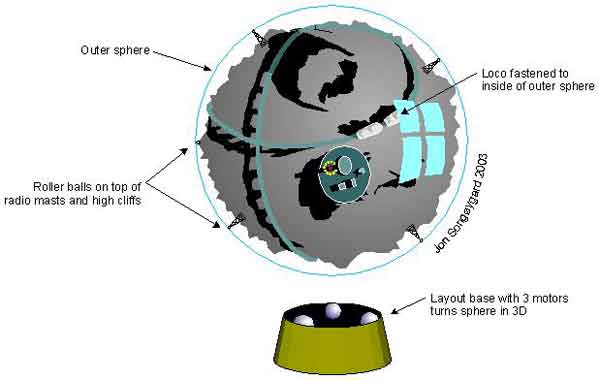
” My second idea was further out in space. First, I got the idea of letting the whole asteroid turn, while the ‘train’ was immobile (the loco could then be attached to the string from the ceiling). Here, the added strength of several wheels on the Traveller would be a necessity.
“Then I realized that this static view of the train could be rather boring, so I added an ‘atmosphere’ outside the asteroid! This outer sphere should be as crystal clear as possible, as you’re going to view the layout through it. The loco could now be attached to the inside of this sphere. To keep the asteroid in place inside, some kind of roller bearings should be put on top of the highest cliffs (and on top of large buildings, radio masts, and so on).
“Then this whole thing would be placed on top of a motor drive that would give the sphere a free moving action — spinning slowly in different directions, so that the viewer can see the train from all sides! The point is that when the train runs, it makes the whole asteroid turn, inside the sphere!
“That’s all about the Globe Railroad. I hope we’ll all return safely from this journey (chances are good)!”
Pure fiction? Or a future direction for model railroading? You be the judge!
Editor’s Note: Somewhere in his correspondence, Jon listed the influences from his reading that led him to design Copernichaum. They included: the famous Model Railroader article about a Lunar Layout in the April 1978 issue; Jeff Semprebon’s wild Lunar Mining Complex layout in these pages; and the “spacey” photographs of Brian Wilson on his website (under “digital photo fun”).
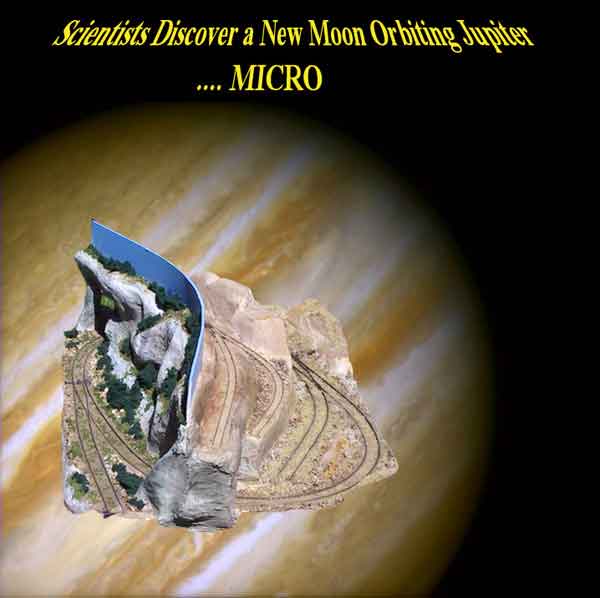
Photo courtesy Brian Wilson
Leave a Reply